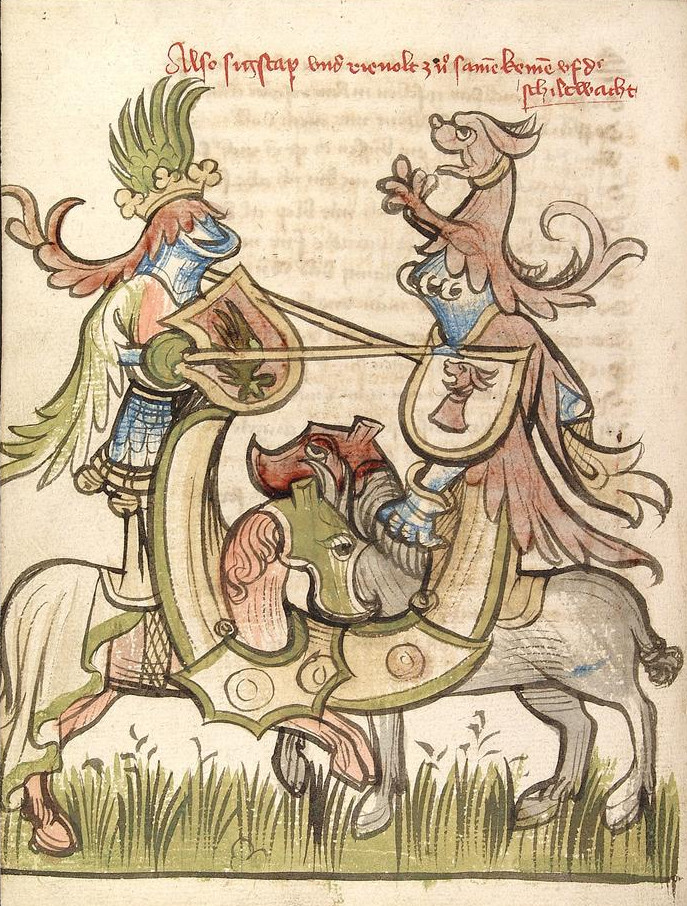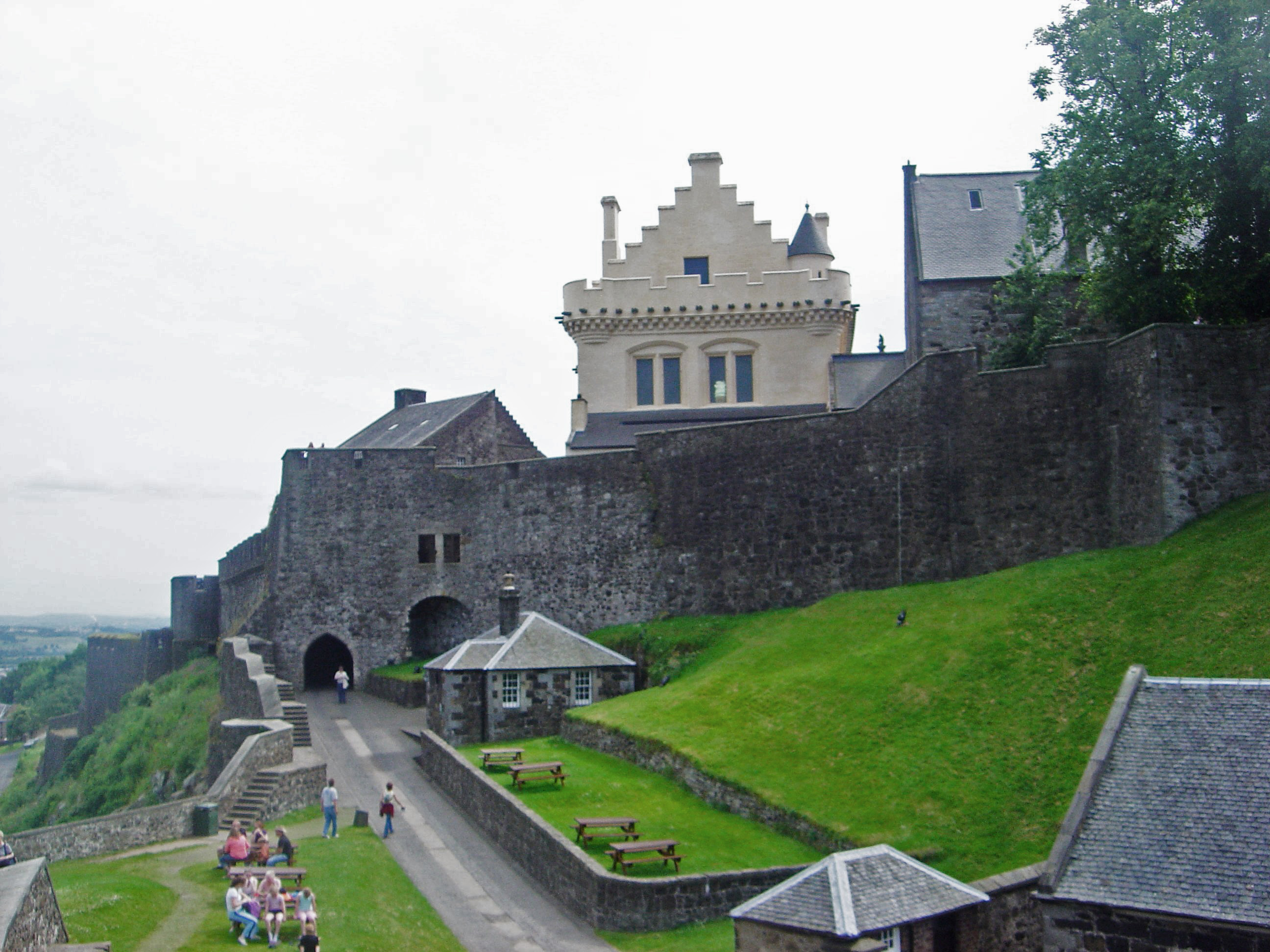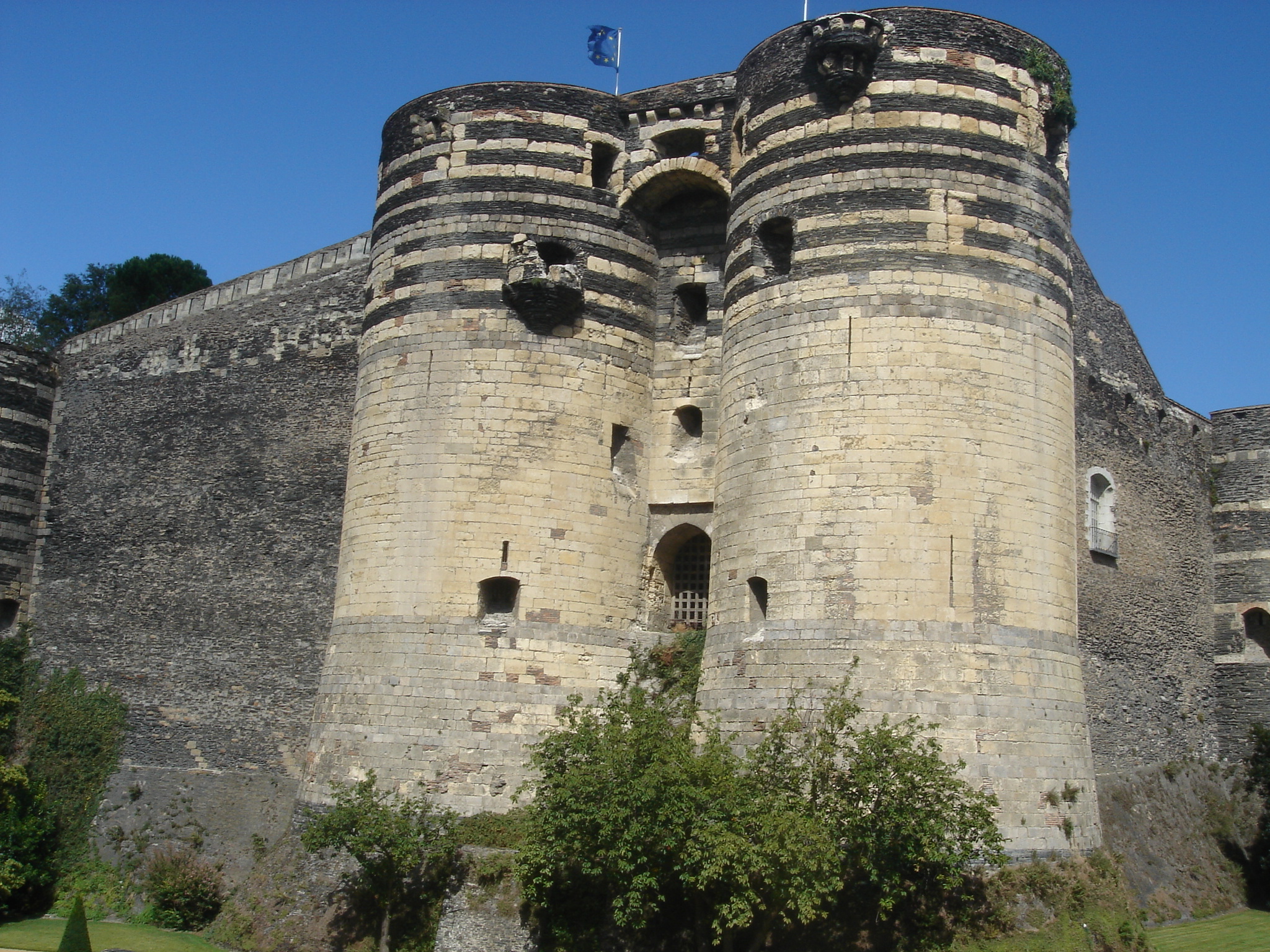|
Round Table (tournament)
A Round Table was a festive event during the Middle Ages that involved jousting, feasting, and dancing in imitation of King Arthur's legendary court. Named for Arthur's famed Round Table, the festivals generally involved jousts with blunted weapons, and often celebrated weddings or victories. In some cases participants dressed in the costume of such well-known knights as Lancelot, Tristan, and Palamedes. History The earliest Round Table was recorded in 1223, when the Crusader lord of Beirut held one in Cyprus to celebrate the knighting of his eldest sons. Round Tables were popular in various European countries through the rest of the Middle Ages and were at times very elaborate. Round Tables in England Edward I held one on the occasion of his marriage, and one in 1284 to celebrate his conquest of Wales; and is recorded as sponsoring several as late as 1304. One artefact that has survived from this fashion in England is the " Winchester Round Table" in the Great Hall at Winche ... [...More Info...] [...Related Items...] OR: [Wikipedia] [Google] [Baidu] |
Jousting
Jousting is a medieval and renaissance martial game or hastilude between two combatants either on horse or on foot. The joust became an iconic characteristic of the knight in Romantic medievalism. The term is derived from Old French , ultimately from Latin">-4; we might wonder whether there's a point at which it's appropriate to talk of the beginnings of French, that is, when it wa ... , ultimately from Latin "to approach, to meet". The word was loaned into Middle English around 1300, when jousting was a very popular sport among the Anglo-Normans, Anglo-Norman knighthood. The synonym tilt (as in tilting at windmills) dates . Jousting on horse is based on the military use of the lance by heavy cavalry. It transformed into a specialized sport during the Late Middle Ages, and remained popular with the nobility in England and Wales, Germany and other parts of Europe throughout the whole of the 16th century (while in France, it was discontinued after the death of King Henry II ... [...More Info...] [...Related Items...] OR: [Wikipedia] [Google] [Baidu] |
Order Of The Garter
The Most Noble Order of the Garter is an order of chivalry founded by Edward III of England in 1348. The most senior order of knighthood in the Orders, decorations, and medals of the United Kingdom, British honours system, it is outranked in United Kingdom order of precedence, precedence only by the Award, decorations of the Victoria Cross and the George Cross. The Order of the Garter is dedicated to the image and Coat of arms, arms of Saint George, England's patron saint. Appointments are at the Monarchy of the United Kingdom, Sovereign's sole discretion, typically made in recognition of national contribution, service to the Crown, or for distinguished personal service to the Monarch. Membership of the order is limited to the sovereign, the Prince of Wales, and no more than 24 living members, or Companions. The order also includes Supernumerary Knights and Ladies (e.g., members of the British royal family and foreign monarchs). The order's emblem is a garter (stockings), gar ... [...More Info...] [...Related Items...] OR: [Wikipedia] [Google] [Baidu] |
Mary, Queen Of Scots
Mary, Queen of Scots (8 December 1542 – 8 February 1587), also known as Mary Stuart or Mary I of Scotland, was List of Scottish monarchs, Queen of Scotland from 14 December 1542 until her forced abdication in 1567. The only surviving legitimate child of James V of Scotland, Mary was six days old when her father died and she inherited the throne. During her childhood, Kingdom of Scotland, Scotland was governed by regents, first by the heir to the throne, James Hamilton, Earl of Arran, and then by her mother, Mary of Guise. In 1548, she was betrothed to Francis II of France, Francis, the Dauphin of France, and was sent to be brought up in Kingdom of France, France, where she would be safe from invading Kingdom of England, English forces during the Rough Wooing. Mary Wedding of Mary, Queen of Scots, and Francis, Dauphin of France, married Francis in 1558, becoming queen consort of France from his accession in 1559 until his death in December 1560. Widowed, Mary Entry of Mary, Q ... [...More Info...] [...Related Items...] OR: [Wikipedia] [Google] [Baidu] |
Thomas Thomson (advocate)
Thomas Thomson Fellow of the Royal Society of Edinburgh, FRSE FSA Scot (10 November 1768 – 2 October 1852) was a Scottish advocate, antiquarian and archivist who served as Principal Clerk of Session (1828–1852) and as secretary of the literary section of the Royal Society of Edinburgh (1812–20). Life Thomas Thomson was born in Dailly manse on 10 November 1768, the eldest son of Rev Thomas Thomson, minister of Dailly in Ayrshire, and his second wife, Mary, daughter of Francis Hay. John Thomson of Duddingston, John Thomson was a younger brother. After attending the parish school of Dailly, he entered the University of Glasgow at age 13, where he graduated with an MA on 27 April 1789. He attended classes in theology and law at the University of Edinburgh from 1789 to 1791. He passed the Scottish bar as an advocate on 10 December 1793. His early Edinburgh address was 19 North Castle Street. Here he was a neighbour and close friend to Walter Scott, at that time also a fellow a ... [...More Info...] [...Related Items...] OR: [Wikipedia] [Google] [Baidu] |
Wild Knight And The Black Lady
The tournament of the Wild Knight and the Black Lady was an event held twice in Edinburgh by James IV of Scotland, in June 1507 and May 1508. Themes The invitation outlining the articles of the tournament to be sent to France was illuminated with gold leaf in February 1507. The priest John Ramsay wrote out the words and Thomas Galbraith of the Chapel Royal may have been the illuminator. The document itself does not survive, but some of the text was preserved. The articles were issued by the Marchmont Herald on behalf of the ''Chevalier Sauvage à la Dame Noire'', the Wild Knight to the Black Lady, and gave details of the events to be held at Edinburgh, featuring (for the second event in 1508) Antoine d'Arces, seigneur de La Bastie as the White Knight. Bluemantle or Rothesay Herald, sent abroad in March 1507 to announce the birth of James, Duke of Rothesay, may have carried the invitation to the courts of France, Spain, and Portugal. Painters were supplied with glue, chalk, po ... [...More Info...] [...Related Items...] OR: [Wikipedia] [Google] [Baidu] |
James IV Of Scotland
James IV (17 March 1473 – 9 September 1513) was List of Scottish monarchs, King of Scotland from 11 June 1488 until his death at the Battle of Flodden in 1513. He inherited the throne at the age of fifteen on the death of his father, James III of Scotland, James III, at the Battle of Sauchieburn, following a rebellion in which the younger James was the figurehead of the rebels. James IV is generally regarded as the most successful of the House of Stuart, Stewart monarchs of Scotland. He was responsible for a major expansion of the Royal Scots Navy, Scottish royal navy, which included the founding of two royal dockyards and the acquisition or construction of 38 ships, including the ''Great Michael'', the largest warship of its time. James was a patron of the arts and took an active interest in the law, literature and science. With his patronage the Chepman and Myllar Press, printing press came to Kingdom of Scotland, Scotland, the University of Aberdeen and the Royal College o ... [...More Info...] [...Related Items...] OR: [Wikipedia] [Google] [Baidu] |
Norris J
Norris or Noris may refer to: Places In Canada *Norris, Ontario, in Algoma District In the United Kingdom * Hampstead Norreys (or Norris), Berkshire In the United States * Norris, Illinois * Norris, Mississippi * Norris, Missouri * Norris, Nebraska * Norris, South Carolina * Norris, Tennessee, named after George William Norris * Norris Dam, which forms Norris Lake, Tennessee * Norris Geyser Basin in Yellowstone National Park * Norristown, Pennsylvania * Lake Norris, Florida In Germany * Norisring, street circuit in Nuremberg Companies * Norris Locomotive Works * Norisbank, a bank in Germany * T. Norris & Son, London, hand-tool makers Buildings * Norris House, Palo Alto, California, U.S. * Norris-Heartt House, Raleigh, North Carolina, U.S. * Norris-Holland-Hare House, Holly Springs, North Carolina, U.S. Other *Norris (given name) *Norris (surname) *List of storms named Norris, list of tropical cyclones assigned with the name Norris * Noris (pencil), ... [...More Info...] [...Related Items...] OR: [Wikipedia] [Google] [Baidu] |
King Of Naples
The following is a list of rulers of the Kingdom of Naples, from its first Sicilian Vespers, separation from the Kingdom of Sicily to its merger with the same into the Kingdom of the Two Sicilies. Kingdom of Naples (1282–1501) House of Anjou In 1382, the Kingdom of Naples was inherited by Charles III of Naples, Charles of Durazzo, King of Hungary, great grandson of King Charles II of Naples. After this, the Capetian House of Anjou, House of Anjou of Naples was renamed House of Anjou-Durazzo, when Charles married his first cousin Margaret of Durazzo, member of a prominent Neapolitan noble family. House of Valois-Anjou (disputed) Joanna of Naples had refused to name her enemy Charles of Durazzo as heir to the Neapolitan throne despite him ending up succeeding her anyway. If Charles' line was ignored, the subsequent heirs would be the descendants of Margaret, Countess of Anjou, a daughter of Charles II of Naples; the line pointed to the List of French monarchs, kings of Fran ... [...More Info...] [...Related Items...] OR: [Wikipedia] [Google] [Baidu] |
René Of Anjou
René of Anjou (; ; 16 January 1409 – 10 July 1480) was Duke of Anjou and Count of Provence from 1434 to 1480, who also reigned as King of Naples from 1435 to 1442 (then Aragonese conquest of Naples, deposed). Having spent his last years in Aix-en-Provence, he is known in France as the Good King René (; ). René was a member of the House of Valois-Anjou, a cadet branch of the French royal house, and the great-grandson of John II of France. He was a prince of the blood, and for most of his adult life also the brother-in-law of the reigning king Charles VII of France. Other than the aforementioned titles, he was also Duke of Bar from the 1420s onwards and Duke of Lorraine from 1431 to 1453. Biography René was born on 16 January 1409 in the castle of Angers. He was the second son of Duke of Anjou, Duke Louis II of Anjou, Louis II of Duchy of Anjou, Anjou, King of Naples, by Yolande of Aragon, Yolanda of Kingdom of Aragon, Aragon. René was the brother of Marie of Anjou, w ... [...More Info...] [...Related Items...] OR: [Wikipedia] [Google] [Baidu] |
Tournai
Tournai ( , ; ; ; , sometimes Anglicisation (linguistics), anglicised in older sources as "Tournay") is a city and Municipalities in Belgium, municipality of Wallonia located in the Hainaut Province, Province of Hainaut, Belgium. It lies by road southwest of the centre of Brussels on the river Scheldt, and is part of Eurometropolis Lille–Kortrijk–Tournai, In 2022, the municipality of Tournai had an estimated population of 68,518 people. Tournai is one of the oldest cities in Belgium and has played an important role in the country's cultural history. It was the first capital of the Francia, Frankish Empire, with Clovis I being born here. Geography Tournai lies by road southwest of the centre of Brussels on the river Scheldt. Administratively, the town and municipality is part of the Hainaut Province, Province of Hainaut, in the Wallonia region of southwest Belgium. The municipality has an area of . Tournai has its own Arrondissements of Belgium, arrondissements, both ad ... [...More Info...] [...Related Items...] OR: [Wikipedia] [Google] [Baidu] |
Magdeburg
Magdeburg (; ) is the Capital city, capital of the Germany, German States of Germany, state Saxony-Anhalt. The city is on the Elbe river. Otto I, Holy Roman Emperor, Otto I, the first Holy Roman Emperor and founder of the Archbishopric of Magdeburg, was buried in the city's Magdeburg Cathedral, cathedral after his death. Magdeburg's version of German town law, known as Magdeburg rights, spread throughout Central Europe, Central and Eastern Europe. In the Late Middle Ages, Magdeburg was one of the largest and most prosperous German cities and a notable member of the Hanseatic League. One of the most notable people from the city was Otto von Guericke, famous for his experiments with the Magdeburg hemispheres. Magdeburg has experienced three major devastations in its history. In 1207 the first catastrophe struck the city, with a fire burning down large parts of the city, including the Magdeburg Cathedral#Previous building, Ottonian cathedral. The Catholic League (German), Catholi ... [...More Info...] [...Related Items...] OR: [Wikipedia] [Google] [Baidu] |
Roger Sherman Loomis
Roger Sherman Loomis (1887–1966) was an American scholar and one of the foremost authorities on medieval and Arthurian literature. Loomis is perhaps best known for showing the roots of Arthurian legend, in particular the Holy Grail, in native Celtic mythology. Biography Roger Sherman Loomis was the son of Rev. Henry Loomis and Jane Herring Greene, the grandnephew of William Maxwell Evarts, and the great-great-grandson of American founding father Roger Sherman. Born on October 31, 1887, in Yokohama, Japan, he was educated at the Hotchkiss School in Lakeville, Connecticut. He earned a Bachelor of Arts degree from Williams College in 1909, a Master of Arts degree from Harvard University in 1910, and, as a Rhodes Scholar, a Bachelor of Letters (BLitt) degree at New College, Oxford, in 1913. His BLitt dissertation, written under the supervision of Arthur Napier and C. F. Bell, was titled ''Illustrations of the Romances in Mediæval English Art''. He held honorary degrees f ... [...More Info...] [...Related Items...] OR: [Wikipedia] [Google] [Baidu] |







